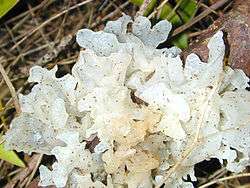Tremellales
| Tremellales | |
|---|---|
 | |
| Gelatinous fruit body of Tremella fuciformis, a commercially cultivated species | |
| Scientific classification | |
| Kingdom: | Fungi |
| Subkingdom: | Dikarya |
| Phylum: | Basidiomycota |
| Subphylum: | Agaricomycotina |
| Class: | Tremellomycetes |
| Order: | Tremellales Rea |
| Families | |
|
Carcinomycetaceae | |
The Tremellales are an order of fungi in the class Tremellomycetes. The order contains both teleomorphic and anamorphic species, most of the latter being yeasts. All teleomorphic species in the Tremellales are parasites of other fungi, though the yeast states are widespread and not restricted to hosts. Basidiocarps (fruit bodies), when produced, are gelatinous.
The order currently comprises 8 families, containing around 300 valid species. Significant genera include Tremella, two species of which are edible and commercially cultivated,[1] and the yeast genera Cryptococcus and Trichosporon, several species of which are human pathogens.[2][3]
History
The order Tremellales was created by Carleton Rea in 1922 for species in which the basidia were "tremelloid" (globose to ellipsoid with vertical or diagonal septa). Rea placed within it one family, the Tremellaceae, having the same characteristics as the order.
This circumscription was generally accepted until the 1980s. In 1945, however, G.W. Martin proposed a substantial extension of the order to include all the species within the (now obsolete) class Heterobasidiomycetes except for the rusts and the smuts. Martin therefore included within the Tremellales not only the Tremellaceae, but also the Auriculariaceae, Dacrymycetaceae, Hyaloriaceae, Phleogenaceae, Septobasidiaceae, Sirobasidiaceae, and Tulasnellaceae (including Ceratobasidium).[4] This extended version of the order was not widely adopted, but was used in a number of publications by Martin himself[5] and, as late as the 1970s, by his student Bernard Lowy.[6]
A more precise revision was undertaken in 1984, when Bandoni used transmission electron microscopy to investigate the ultrastructure of the septal pore apparatus in species of the Tremellales. This revealed that Tremella and its allies were distinct from Exidia and its allies, despite both groups having tremelloid basidia. Bandoni referred the latter group to the Auriculariales, restricting the Tremellales to the Tremellaceae, Sirobasidiaceae, and Tetragoniomycetaceae.[7]
Current status
Molecular research, based on cladistic analysis of DNA sequences, confirms Bandoni's split between the tremelloid and exidioid fungi and extends the circumscription of the tremelloid group by including several yeast genera whose status was formerly uncertain. Molecular research has also indicated that the genus Filobasidiella (together with its yeast state Cryptococcus) and the genus Syzygospora should be included within the group, even though species in these genera do not have tremelloid basidia.[8][9] The Trichosporonaceae, a family of yeasts, is sometimes placed in its own separate order (the Trichosporonales),[10] but current consensus places the family within the Tremellales.[11][12] Several genera — Sigmogloea,[13] Tremellina,[14] and Xenolachne[15] — whose family placement is uncertain are also included in the order.
References
- ↑ Hanelt P, Buttner, R. (2001). Mansfeld's Encyclopedia of Agricultural and Horticultural Crops: (Except Ornamentals). Santa Clara, CA: Springer-Verlag TELOS. p. 23. ISBN 3-540-41017-1. Retrieved 2010-04-21.
- ↑ Perfect JR. (2004). "Genetic requirements for virulence in Cryptococcus neoformans". In Domer JE, Kobayashi GS. Human Fungal Pathogens (The Mycota). Berlin: Springer. p. 89. ISBN 3-540-42629-9. Retrieved 2010-04-21.
- ↑ Wolf DG, Falk R, Hacham M, Theelen B, Boekhout T, Scorzetti G, Shapiro M, Block C, Salkin IF, Polacheck I (2001). "Multidrug-Resistant Trichosporon asahii Infection of Nongranulocytopenic Patients in Three Intensive Care Units". Journal of Clinical Microbiology. 39 (12): 4420–4425. doi:10.1128/JCM.39.12.4420-4425.2001. PMC 88559
 . PMID 11724855.
. PMID 11724855. - ↑ Martin GW. (1945). "The classification of the Tremellales". Mycologia. 37 (5): 527–542. doi:10.2307/3754690. JSTOR 3754690.
- ↑ Martin GW. (1952). "Revision of the North Central Tremellales". University of Iowa Studies in Natural History. 19 (3): 1–112.
- ↑ Lowy B. (1971). Flora Neotropica 6: Tremellales. New York: Hafner. ISBN 0-89327-220-5.
- ↑ Bandoni RJ. (1984). "The Tremellales and Auriculariales: an alternative classification". Transactions of the Mycological Society of Japan. 25: 489–530.
- ↑ Fell JW, Boekhout T, Fonseca A, Scorzetti G, Statzell-Tallman A (2000). "Biodiversity and systematics of basidiomycetous yeasts as determined by large-subunit rDNA D1/D2 domain sequence analysis" (PDF). International Journal of Systematic and Evolutionary Microbiology. 50 (3): 1351–1371. doi:10.1099/00207713-50-3-1351. PMID 10843082. Retrieved 2010-04-21.
- ↑ Findley K, Rodriguez-Carres M, Metin B, Kroiss J, Fonseca A, Vilgalys R, Heitman J (2009). "Phylogeny and Phenotypic Characterization of Pathogenic Cryptococcus Species and Closely Related Saprobic Taxa in the Tremellales". Eukaryotic Cell. 8 (3): 353–361. doi:10.1128/EC.00373-08. PMC 2653247
 . PMID 19151324.
. PMID 19151324. - ↑ Fell JW, Scorzetti G (2004). "Reassignment of the basidiomycetous yeasts Trichosporon pullulans to Guehomyces pullulans gen. nov., comb. nov. and Hyalodendron lignicola to Trichosporon lignicola comb. nov" (PDF). International Journal of Systematic and Evolutionary Microbiology. 54 (Pt 3): 995–998. doi:10.1099/ijs.0.03017-0. PMID 15143054. Retrieved 2010-04-25.
- ↑ Hibbett DS, et al. (2007). "A higher-level phylogenetic classification of the Fungi". Mycological Research. 111 (Pt 5): 509–547. doi:10.1016/j.mycres.2007.03.004. PMID 17572334.
- ↑ "Genus Record Details-Trichosporon". Index Fungorum. CAB International. Retrieved 2010-04-25.
- ↑ "Genus Record Details-Sigmogloea". Index Fungorum. CAB International. Retrieved 2010-04-25.
- ↑ "Genus Record Details-Tremellina". Index Fungorum. CAB International. Retrieved 2010-04-25.
- ↑ "Genus Record Details-Xenolachne". Index Fungorum. CAB International. Retrieved 2010-04-25.